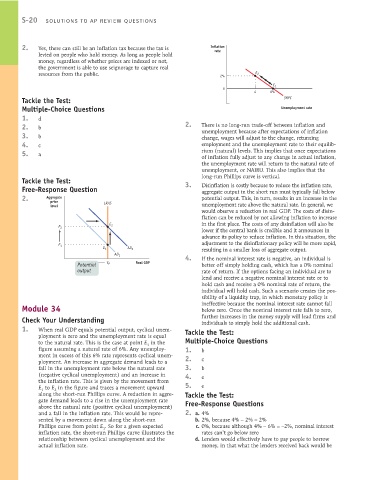Page 866 - Krugmans Economics for AP Text Book_Neat
P. 866
S-20 SOLUTIONS TO AP REVIEW QUESTIONS
2. Yes, there can still be an inflation tax because the tax is Inflation
rate
levied on people who hold money. As long as people hold
money, regardless of whether prices are indexed or not,
the government is able to use seignorage to capture real
resources from the public. 2% E 2
E 1
0
4 6%
Tackle the Test: SRPC
Multiple-Choice Questions Unemployment rate
1. d
2. b 2. There is no long-run trade-off between inflation and
3. b unemployment because after expectations of inflation
change, wages will adjust to the change, returning
4. c employment and the unemployment rate to their equilib-
5. a rium (natural) levels. This implies that once expectations
of inflation fully adjust to any change in actual inflation,
the unemployment rate will return to the natural rate of
unemployment, or NAIRU. This also implies that the
long-run Phillips curve is vertical.
Tackle the Test: 3.
Free-Response Question Disinflation is costly because to reduce the inflation rate,
aggregate output in the short run must typically fall below
2. Aggregate potential output. This, in turn, results in an increase in the
price LRAS
level unemployment rate above the natural rate. In general, we
would observe a reduction in real GDP. The costs of disin-
flation can be reduced by not allowing inflation to increase
in the first place. The costs of any disinflation will also be
E 2
P 2
lower if the central bank is credible and it announces in
advance its policy to reduce inflation. In this situation, the
adjustment to the disinflationary policy will be more rapid,
P 1
E 1 AD 2
resulting in a smaller loss of aggregate output.
4. If the nominal interest rate is negative, an individual is
AD 1
Real GDP
Potential Y P better off simply holding cash, which has a 0% nominal
output rate of return. If the options facing an individual are to
lend and receive a negative nominal interest rate or to
hold cash and receive a 0% nominal rate of return, the
individual will hold cash. Such a scenario creates the pos-
sibility of a liquidity trap, in which monetary policy is
Module 34 ineffective because the nominal interest rate cannot fall
below zero. Once the nominal interest rate falls to zero,
Check Your Understanding further increases in the money supply will lead firms and
individuals to simply hold the additional cash.
1. When real GDP equals potential output, cyclical unem- Tackle the Test:
ployment is zero and the unemployment rate is equal
to the natural rate. This is the case at point E in the Multiple-Choice Questions
1
figure assuming a natural rate of 6%. Any unemploy- 1. b
ment in excess of this 6% rate represents cyclical unem- 2.
ployment. An increase in aggregate demand leads to a c
fall in the unemployment rate below the natural rate 3. b
(negative cyclical unemployment) and an increase in 4. e
the inflation rate. This is given by the movement from 5.
E to E in the figure and traces a movement upward e
1 2
along the short-run Phillips curve. A reduction in aggre- Tackle the Test:
gate demand leads to a rise in the unemployment rate Free-Response Questions
above the natural rate (positive cyclical unemployment)
and a fall in the inflation rate. This would be repre - 2. a. 4%
sented by a movement down along the short-run b. 2%, because 4% − 2% = 2%
Phillips curve from point E . So for a given expected c. 0%, because although 4% − 6% =−2%, nominal interest
1
inflation rate, the short-run Phillips curve illustrates the rates can’t go below zero
relationship between cyclical unemployment and the d. Lenders would effectively have to pay people to borrow
actual inflation rate. money, in that what the lenders received back would be

